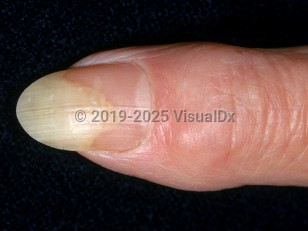Onycholysis - Nail and Distal Digit
Alerts and Notices
Important News & Links
Synopsis

Fingernail onycholysis is more common in women than men and is common in patients with hand dermatitis. Fingernail and toenail onycholysis is most often caused by trauma. Other causes of onycholysis include hyper- and hypothyroidism, pregnancy, porphyria, pellagra, syphilis, atopic dermatitis, psoriasis, irritant or allergic contact dermatitis, lichen planus, congenital abnormalities of the nails, onychomycosis and other infections, and underlying malignancies. Tetracycline, quinolones, oral contraceptives, and certain chemotherapeutic agents are the most frequently associated medications. Systemic retinoids may also be culprits.
Blistering diseases, such as porphyria cutanea tarda or pseudoporphyria, will give rise to pain followed by onycholysis when a subungual vesicle or bulla appears. This is induced by sunlight and is known as photoonycholysis.
In children, onycholysis is most often due to trauma particularly when one or a few nails are affected. Psoriasis, lichen planus, and congenital abnormalities are also possibilities. If these etiologies have been ruled out, a systemic cause should be explored.
Codes
L60.1 – Onycholysis
SNOMEDCT:
75789001 – Onycholysis
Look For
Subscription Required
Diagnostic Pearls
Subscription Required
Differential Diagnosis & Pitfalls

Subscription Required
Best Tests
Subscription Required
Management Pearls
Subscription Required
Therapy
Subscription Required
Drug Reaction Data
Subscription Required
References
Subscription Required
Last Updated:06/04/2018
 Patient Information for Onycholysis - Nail and Distal Digit
Patient Information for Onycholysis - Nail and Distal Digit- Improve treatment compliance
- Reduce after-hours questions
- Increase patient engagement and satisfaction
- Written in clear, easy-to-understand language. No confusing jargon.
- Available in English and Spanish
- Print out or email directly to your patient


